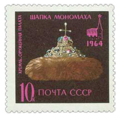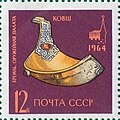Category:Muscovitean art on stamps
The "Muscovitean Style" or "Muscovitean Empire Style" (German: "Moskowitischer Reichsstil") was the predominant art in the time 1400-1600 in the counties Eastern of the river "Weichsel" (= German name, Polish: "Wisla", Latin: "Vistula"). One can see in this style a variant or the successor of the "Byzantinum Style(s)".
Predecessor style: Byzantinum style(s)
Sucessor style: Baroque, Classicism
Parallel styles: Renaissance in Europe, Mannerism
One (very important) cultural detail was the general spreading of the Russian language as language of the Muscovitean Empire. During Belarus and Ukraine it accepted still, the spreading of the Russian ended in the Baltic countries and in Poland and also in the countries Southern of this empire which were in former times under Roman influence. It was the language of the poorer layers of population which was arisen from the Old-Ruthenian language. Belarusian, for instance, is considered as archaic and unsophisticated especially in Belarus and is there only spoken by ca. 10% of the population. There exist the tradition, that the Muscovian (modern Russian) came from Bulgaria, which was used as official Church language ("Bulgaria" = "land of the people from the river "Volga"). The Ukrainians have long time resist the Belarussian invasion trials from the North, although there the Russian language is seen as the language of the "Kievan Rus" (= White Russia or Great Russia)), however the "Musovian" is not the same what is called the "Ruthenian" of the "Rus". Firstly in 1569, with the Polish-Lithuanian-Saxonian personal union, it cames to a flooding of the "Rusyn"-language over the East Slavonic territories. Nevertheless, the rulers of Lithuania, for instance, spoke again Lithuanian. The old humanists have anyway always seen the Lithuanian as "ruined" version of Latin.; The Orthodox Church with her Byzantine tradition contributes his part for the spreading of the Muscovian language in later time. As Ruthenian was always in a kind of diglossic opposition to Church Slavonic, it was and still is often called prosta(ja) mova (Cyrillic: "проста(я) мова", = literally '"simple language'"). The "Muscovite Kingdom" was a Feudal kingdom stretching from Europe over the "Nowgorod Rus" in the North until to the borders of the Mongol Empire. It was one of the oldest kingdoms of the world, second only to the Erkatian Empire on the territory of the contemporary Iran. The country has been cut in half since the establishment of the Golden Horde upon the Kaphari mountains, and the Feudal Lords south of the Kaphari have withdrawn their allegiance from the emperor. Sometime the "Grand Duchy of Moscow" is also called as "Muscovite Rus" and from there as "Muscovite Empire".
Media in category "Muscovitean art on stamps"
The following 36 files are in this category, out of 36 total.
-
1961 CPA 2553.jpg 1,273 × 1,786; 302 KB
-
1967 CPA 3580.jpg 622 × 451; 163 KB
-
1977 CPA 4760 - 4765 minisheet.jpg 4,402 × 2,514; 1.93 MB
-
1991 CPA 6327.jpg 892 × 1,237; 196 KB
-
1991 CPA 6328.jpg 884 × 1,237; 208 KB
-
1991 CPA 6329.jpg 884 × 1,237; 209 KB
-
1991 CPA 6330.jpg 886 × 1,237; 205 KB
-
1991 CPA 6331.jpg 885 × 1,237; 207 KB
-
1992. Stamp of Belarus 0010.jpg 342 × 244; 23 KB
-
1992. Stamp of Belarus 0013.jpg 243 × 345; 22 KB
-
Stamp 1973 Romania MiNr3165 pm B002a.jpg 748 × 920; 400 KB
-
Stamp of Russia 1992 No 38.jpg 1,832 × 2,550; 1 MB
-
Stamp-ussr1977-wonders-of-ancient-russian-culture.png 4,433 × 2,445; 23.75 MB
-
The Soviet Union 1964 CPA 3143 stamp (Kremlin Armoury. Golden quiver).png 898 × 896; 1.98 MB
-
The Soviet Union 1964 CPA 3144 stamp (Kremlin Armoury. Monomakh's Cap).png 895 × 896; 1.91 MB
-
The Soviet Union 1964 CPA 3145 stamp (Kremlin Armoury. Golden kovsh).jpg 897 × 897; 136 KB
-
The Soviet Union 1964 CPA 3145 stamp (Kremlin Armoury. Golden kovsh).png 897 × 897; 2.03 MB
-
The Soviet Union 1964 CPA 3146 stamp (Kremlin Armoury. Silver bratina).png 897 × 901; 2.01 MB
-
Почтовая марка СССР № 4760. 1977. Шедевры древнерусской культуры.jpg 410 × 294; 77 KB
-
Почтовая марка СССР № 4761. 1977. Шедевры древнерусской культуры.jpg 411 × 295; 76 KB
-
Почтовая марка СССР № 4762. 1977. Шедевры древнерусской культуры.jpg 412 × 294; 82 KB
-
Почтовая марка СССР № 4763. 1977. Шедевры древнерусской культуры.jpg 410 × 294; 79 KB
-
Почтовая марка СССР № 4764. 1977. Шедевры древнерусской культуры.jpg 410 × 294; 73 KB
-
Почтовая марка СССР № 4765. 1977. Шедевры древнерусской культуры.jpg 412 × 295; 76 KB



































